
by Santiago Herrera, Science Lead, Massachusetts Institute of Technology/Woods Hole Oceanographic Institution Joint Program
July 11, 2010
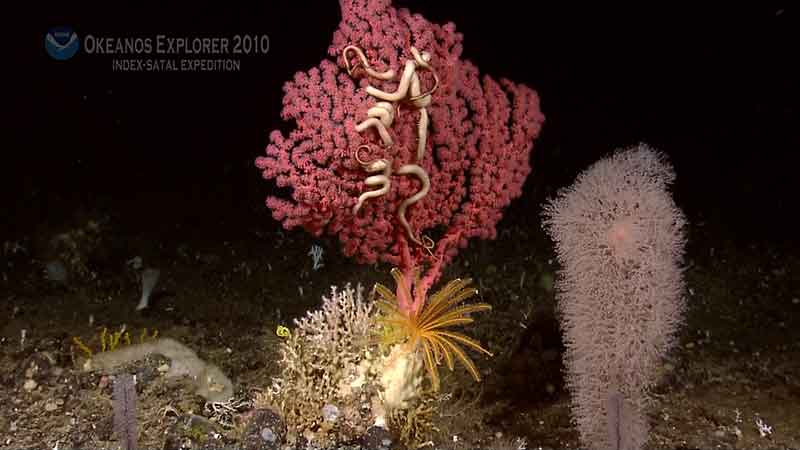
Bubblegum corals (red) lack any form of fused internal skeleton. A complex of microscopic skeletal structures (sclerites) joined by organic cements provide support to the colony. Fleshy brittle stars are usually found in association with these corals. Sea lilies (yellow) are also common. Image courtesy of the NOAA Office of Ocean Exploration and Research, INDEX-SATAL 2010. Download larger version (jpg, 1.2 MB).
Today we had one of the most interesting dives so far during this expedition. The location was the volcanic feature termed “Target K” in the southwestern part of our area of operations. The summit of this seamount reaches a depth of approximately 460 meters below sea level.
During remotely operated vehicle (ROV) dives at similar features in the same depth range as Target K, we have seen that the abundance (amount of animals per area unit) of benthic animals (that live on the seafloor) at the summit are relatively high when compared to the abundance found in deeper areas. This is not surprising considering that these non-chemosynthetic deep-sea communities are composed mainly of suspension feeders (animals that feed on microscopic suspended particles) such as corals, sponges, and sea lilies.
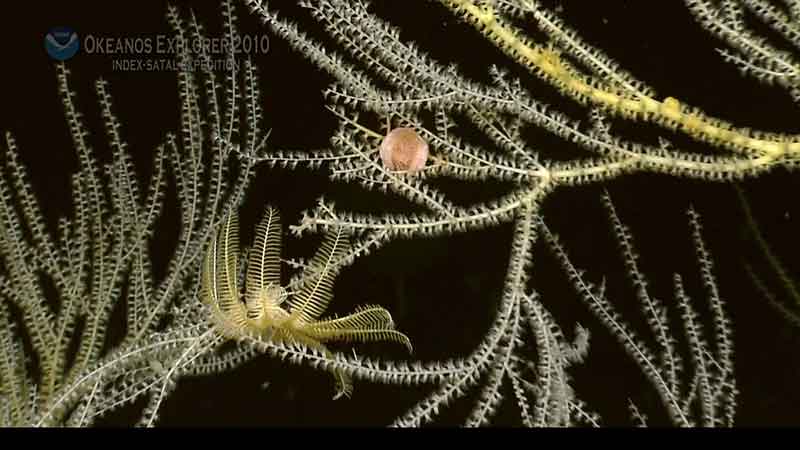
The anemones and sea lilies associated with this bamboo coral are probably taking advantage of their elevated position to capture suspended food particles more efficiently. Image courtesy of the NOAA Office of Ocean Exploration and Research, INDEX-SATAL 2010. Download larger version (jpg, 1.4 MB).
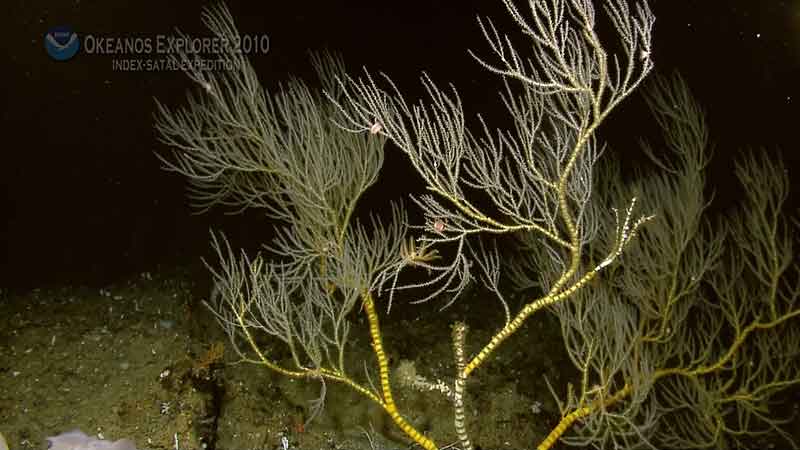
Bamboo corals are characterized dark internodes that resemble the ones found in the terrestrial bamboo plants. Image courtesy of the NOAA Office of Ocean Exploration and Research, INDEX-SATAL 2010. Download larger version (jpg, 1.3 MB).
Suspended food particles are mostly composed of body parts and secretions of planktonic organisms that sink from the surface waters. As these particles sink into the ocean depths, they become consumed and dissolved (transported). As you go deeper, the concentration of food particles in the water column becomes smaller. Food availability is one of the main factors limiting the number of animals that can co-exist in a given area. So, in general, animals at the top of a seamount, such as Target K, obtain more food than the animals on the flanks or base of it; therefore, the animals at the top can grow larger and reproduce more.
On most seamount sites, the communities are dominated by a small number of groups of organisms and are often unique in composition. For example, the summit of the seamount Naung, which has a depth of approximately 500 meters and is separated from Target K by approximately 90 kilometers, has a distinctive community that is dominated by paramuricid sea-fan corals and a few species of sea lilies.
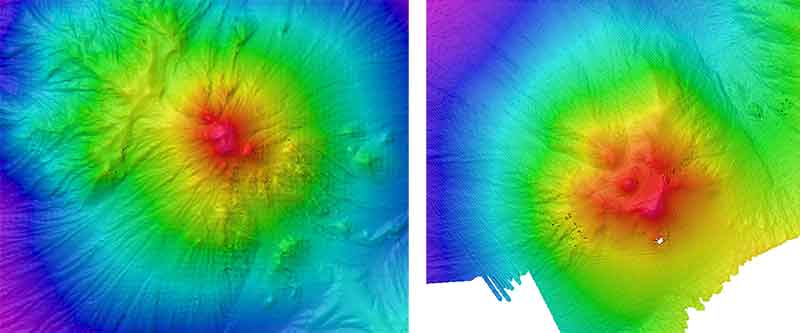
The volcanic features Target K (left) and Naung (right) have very similar conical shapes and depths at summits around 450-500 meters. Target K is 90 kilometers south of Naung. Image courtesy of the NOAA Office of Ocean Exploration and Research, INDEX-SATAL 2010. Download larger version (jpg, 707 KB).
A great contrast to this trend was found at Target K. At this seamount, both the abundance AND diversity of species was exceptionally high! High numbers of individuals and species of at least 10 large groups of corals were observed, including: black corals, hydrocorals, bamboo corals, golden corals, bubblegum corals, soft corals, sea pens, stony corals, and other bottle-brush and fan-like corals. A yet-to-be-determined number of sea lilies and glass sponges were extremely abundant as well.

The seamount Target K (left) has greater abundances and diversity of organisms than seamount Naung (right). Image courtesy of the NOAA Office of Ocean Exploration and Research, INDEX-SATAL 2010. Download larger version (jpg, 967 KB).
But it is not only the diversity of these sessile animals (fixed in one place) that is high, it is also the diversity of animals living on them. Many species of brittle stars, anemones, hermit crabs, barnacles, worms, squat lobsters, fish, and shrimp use the corals, sponges, and sea lilies as their homes. In many cases, these relationships between host (animal providing house) and associate (animal using the house) seemed to be specific (certain associate species restricted to certain host species). In other parts of the world, it has been found that certain deep-sea coral communities have greater diversities than their shallow water equivalents. Could this also be the case in the Coral Triangle?
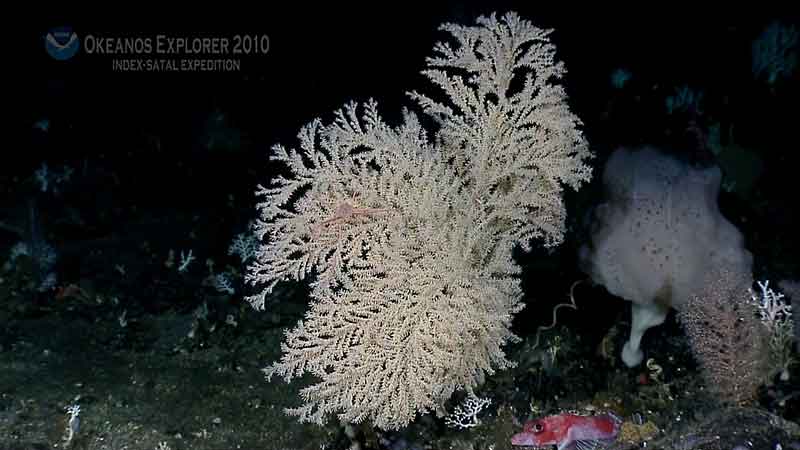
Black corals are a separate group of corals outside the octocorals and hard corals. They produce a flexible proteinaceous black skeleton that is almost invisible when the animal is alive. This is a very large colony found at Target K. Black coral whip, glass sponge, and golden coral are visible to the right. Image courtesy of the NOAA Office of Ocean Exploration and Research, INDEX-SATAL 2010. Download larger version (jpg, 1.2 MB).
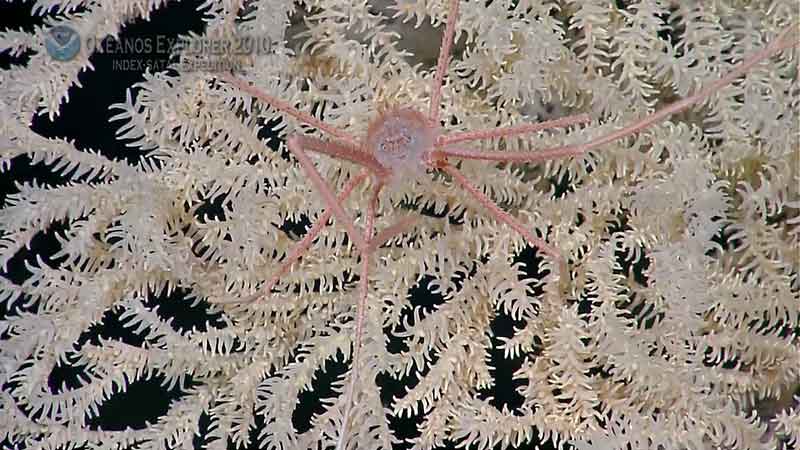
Squat lobsters are a group of animals often found in association with corals, among the most common being black corals and golden corals. Image courtesy of the NOAA Office of Ocean Exploration and Research, INDEX-SATAL 2010. Download larger version (jpg, 1.5 MB).
The exploration of the Sangihe-Talaud region using the underwater and communication technologies available on board NOAA Ship Okeanos Explorer is allowing us to make very detailed observations of the deep-sea animal communities of this region. These observations constitute fundamental material for planning, proposing, and executing future scientific research that will help us answer already stated and other interesting questions such as:
These are just some of the many questions generated by our exploration so far.
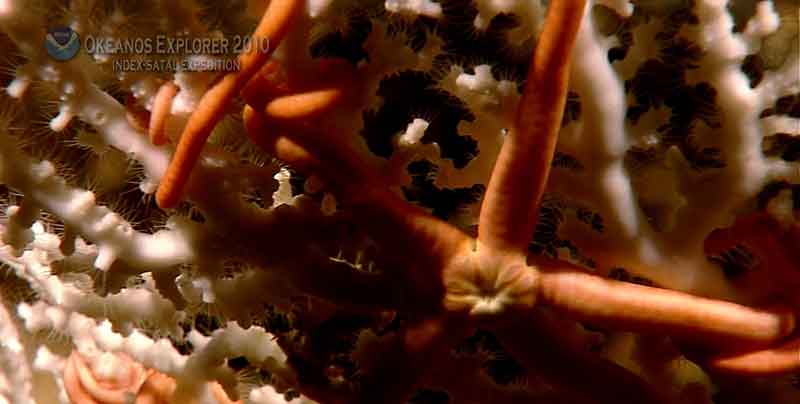
Hydrocorals, also know as stylasterids, are not 'true' corals but are more closely related to hydroids. Fleshy ophiuroids have been commonly found in association with them. Image courtesy of the NOAA Office of Ocean Exploration and Research, INDEX-SATAL 2010. Download larger version (jpg, 1.3 MB).
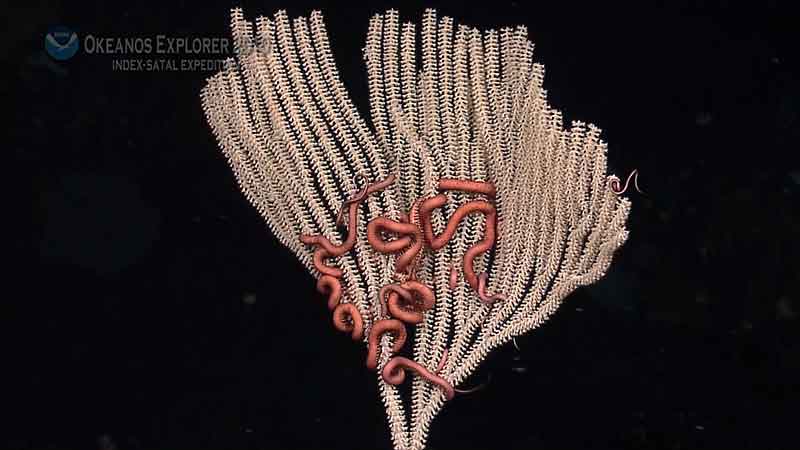
The association of this primnoid sea fan with the fleshy ophiuroids is common in the deep sea around the world. Image courtesy of the NOAA Office of Ocean Exploration and Research, INDEX-SATAL 2010. Download larger version (jpg, 1.0 MB).